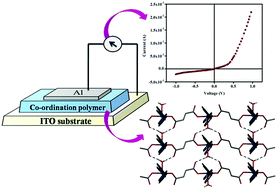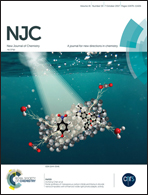Synthesis and structural characterization of a Cu(ii)-based 1D coordination polymer and its application in Schottky devices†
Abstract
A new Cu(II) based one-dimensional coordination polymer (1D CP), [Cu(fum)(4-phpy)2(H2O)] (1) (H2fum = fumaric acid and 4-phpy = 4-phenyl pyridine), has been synthesized and well characterized using elemental analysis, infrared spectra, single crystal X-ray diffraction (SCXRD) techniques, powder X-ray diffraction (PXRD) patterns, scanning electron microscopy (SEM) and thermogravimetric analysis (TGA). In the solid state structure, 1D chains are self-assembled through strong intermolecular hydrogen bonding to give a 2D sheet structure. These 2D sheets are further accumulated to fabricate 3D supramolecular aggregates via weak CH⋯π interactions. The band gap measurement which is equivalent to the HOMO–LUMO gap calculated by density functional theory (DFT) computations confirms the semiconducting properties of the material. To gain insight into the charge transport mechanism of the compound, its mobility, lifetime and diffusion length have been estimated. The analysis indicates that compound 1 may be applied in active electronic devices. Finally, a metal–CP junction Schottky barrier diode has been successfully fabricated and studied in detail.



 Please wait while we load your content...
Please wait while we load your content...